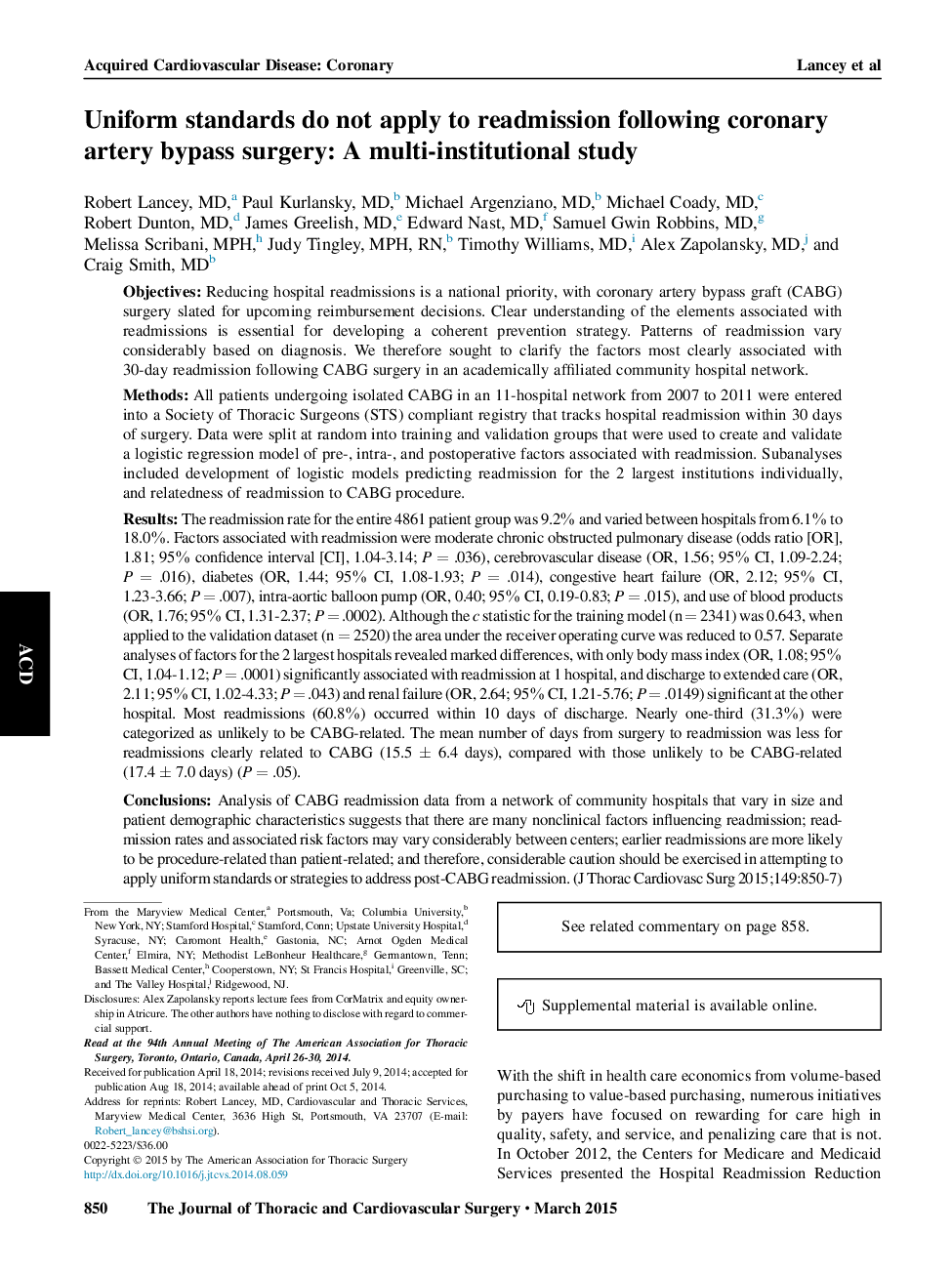| کد مقاله | کد نشریه | سال انتشار | مقاله انگلیسی | نسخه تمام متن |
|---|---|---|---|---|
| 5988930 | 1578600 | 2015 | 9 صفحه PDF | دانلود رایگان |
ObjectivesReducing hospital readmissions is a national priority, with coronary artery bypass graft (CABG) surgery slated for upcoming reimbursement decisions. Clear understanding of the elements associated with readmissions is essential for developing a coherent prevention strategy. Patterns of readmission vary considerably based on diagnosis. We therefore sought to clarify the factors most clearly associated with 30-day readmission following CABG surgery in an academically affiliated community hospital network.MethodsAll patients undergoing isolated CABG in an 11-hospital network from 2007 to 2011 were entered into a Society of Thoracic Surgeons (STS) compliant registry that tracks hospital readmission within 30 days of surgery. Data were split at random into training and validation groups that were used to create and validate a logistic regression model of pre-, intra-, and postoperative factors associated with readmission. Subanalyses included development of logistic models predicting readmission for the 2 largest institutions individually, and relatedness of readmission to CABG procedure.ResultsThe readmission rate for the entire 4861 patient group was 9.2% and varied between hospitals from 6.1% to 18.0%. Factors associated with readmission were moderate chronic obstructed pulmonary disease (odds ratio [OR], 1.81; 95% confidence interval [CI], 1.04-3.14; P = .036), cerebrovascular disease (OR, 1.56; 95% CI, 1.09-2.24; P = .016), diabetes (OR, 1.44; 95% CI, 1.08-1.93; P = .014), congestive heart failure (OR, 2.12; 95% CI, 1.23-3.66; P = .007), intra-aortic balloon pump (OR, 0.40; 95% CI, 0.19-0.83; P = .015), and use of blood products (OR, 1.76; 95% CI, 1.31-2.37; P = .0002). Although the c statistic for the training model (n = 2341) was 0.643, when applied to the validation dataset (n = 2520) the area under the receiver operating curve was reduced to 0.57. Separate analyses of factors for the 2 largest hospitals revealed marked differences, with only body mass index (OR, 1.08; 95% CI, 1.04-1.12; P = .0001) significantly associated with readmission at 1 hospital, and discharge to extended care (OR, 2.11; 95% CI, 1.02-4.33; P = .043) and renal failure (OR, 2.64; 95% CI, 1.21-5.76; P = .0149) significant at the other hospital. Most readmissions (60.8%) occurred within 10 days of discharge. Nearly one-third (31.3%) were categorized as unlikely to be CABG-related. The mean number of days from surgery to readmission was less for readmissions clearly related to CABG (15.5 ± 6.4 days), compared with those unlikely to be CABG-related (17.4 ± 7.0 days) (P = .05).ConclusionsAnalysis of CABG readmission data from a network of community hospitals that vary in size and patient demographic characteristics suggests that there are many nonclinical factors influencing readmission; readmission rates and associated risk factors may vary considerably between centers; earlier readmissions are more likely to be procedure-related than patient-related; and therefore, considerable caution should be exercised in attempting to apply uniform standards or strategies to address post-CABG readmission.
Journal: The Journal of Thoracic and Cardiovascular Surgery - Volume 149, Issue 3, March 2015, Pages 850-857.e1
